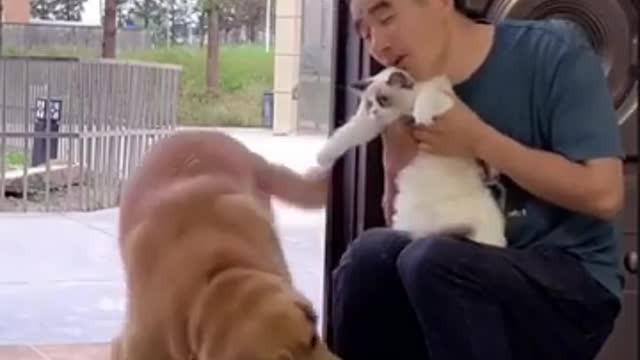Premium Only Content

Cute Cat and Dog playing
Body language of dogs and cats
When introducing your dog to a cat, pay attention to the body language of both animals. If the cat’s ears are pinned back or his tail is swishing back and forth, this is a good indicator that he is displeased. You particularly want to be aware of dog body language that could be potential warning signs. If your dog has a strong prey drive (the inclination to seek out, chase and potentially capture animals seen as prey — usually smaller animals such as cats or rabbits), she might become very focused on the cat. She’ll stiffen, stare, and may start barking or whining. If you see these signs, do not let her near the cat. Ideally, her body language will be loose and relaxed around the cat. It’s OK if she pays attention to the cat, but you don’t want to see her fixated on him.
In addition, a dog’s interaction with a cat can change depending on the environment. Just because your dog is OK with the cat inside the house doesn’t mean she’ll exhibit that same behavior outdoors. She might fixate on the cat and start stalking him when they are outside together. So, be aware of her body language around the cat in each new situation, until you know how she is going to respond toward him.
-
 10:18
10:18
Truther Steve
11 hours agoDO Christians REALLY Know Their Enemy's Power?
2221 -
 12:30
12:30
Actual Justice Warrior
11 hours agoLong Island Prankster Is Going To JAIL
80410 -
 13:36
13:36
Nate The Lawyer
2 days ago $0.44 earnedJudge Removed For Illegally Releasing Criminals From Jail
1.84K11 -
 18:13
18:13
Scammer Payback
3 days agoScammers saying Insane things
3.76K11 -
 1:44
1:44
New York Post Sports
2 days agoCoco Gauff Wins First French Open Title
3.41K -
 8:53
8:53
The Dana Show with Dana Loesch
2 days agoCritics Are LOSING IT Over Marvel's Possible Decision
7.31K9 -
 23:07
23:07
Clownfish TV
2 days agoGen Z Retcons the 1980s...
7.98K31 -
 19:24
19:24
Paul Barron Network
19 days agoStablecoin Bill Passing!✅XRP MASSIVE WIN!🔥
12.7K -
 36:29
36:29
The Brett Cooper Show
15 hours ago $0.43 earnedElon and Simone Biles Have Gone Off The Rails | Episode 38
12.8K11 -
 9:03
9:03
Academy of Ideas
5 days ago $0.94 earnedCarl Jung’s Apocalyptic Vision
12.4K9